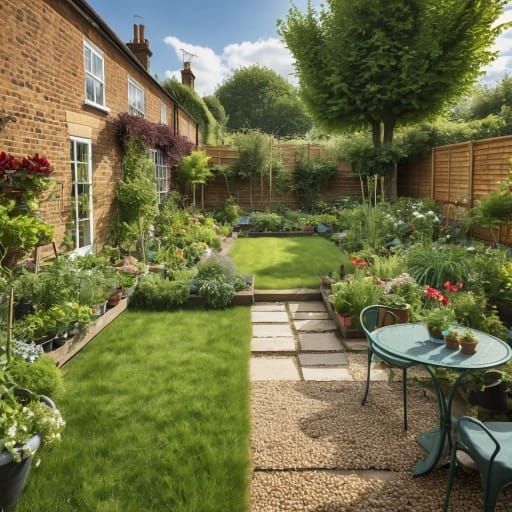How to Protect Your Garden During Stormy and Rainy Seasons
☔ Prevent waterlogging with smart drainage
🌧️ Safeguard plants from heavy rainfall and runoff
💧 Use rain to your advantage with harvesting systems
🌿 Support soil health and structure before damage occurs
The UK’s unpredictable weather can be a blessing and a curse for gardeners. While rain is essential for growth, excessive downpours can ruin your hard work. Knowing how to prepare your garden for wet spells will keep your plants safe, soil strong, and layout intact. Even in constant drizzle, your garden can thrive 🌦️.
Improve Drainage in Key Areas
One of the first signs of trouble during rainy periods is poor drainage. If water is pooling around roots or sitting on paths, it’s time to act. Raised beds, gravel paths, and sloped planting areas can all help direct water where it needs to go 🚿.
You could also install a French drain or soakaway system to reduce surface water. These underground solutions are ideal if your lawn or flowerbeds frequently flood. If you need help installing these, a reliable tradesperson such as Fanatic Plumbers can assist with drainage and irrigation pipework beneath your soil.
Protect Delicate Plants from Rainfall
🌺 Not all plants appreciate being drenched. Soft-stemmed or shallow-rooted varieties can easily become damaged in heavy downpours. Use garden cloches, temporary covers, or position taller shrubs nearby to shelter more delicate companions.
Planting strategically with windbreaks and natural cover can also protect blooms and stems. For example, lavender or ornamental grasses offer some shielding while still allowing airflow.
You can find tips on this from the Gardening Know How blog, especially for wet garden design.
Mulch and Support the Soil Structure
Soil compaction and erosion are major risks during heavy rain 🌧️. When the surface hardens or washes away, it weakens your plants and encourages pests and diseases.
Adding mulch made from bark, straw, or compost helps absorb water, reduce erosion, and prevent splashback onto leaves. It also improves overall soil health over time 🌿.
Looking for help with your garden beds? Our expert planting and maintenance services ensure your borders are both beautiful and weather-ready.
Harvest Rainwater the Smart Way
Make the most of Britain’s frequent showers by capturing rain for future use. Water butts connected to your shed or greenhouse gutters are simple, affordable and reduce reliance on tap water 💧.
Rainwater is naturally softer and ideal for most garden plants. Just ensure you cover your containers with tight-fitting lids to avoid debris and mosquito breeding.
Explore Thompson & Morgan’s rainwater guide for creative rainwater collection ideas.
Avoid Overcrowding in Beds
Tightly planted areas can trap moisture and encourage fungal problems. Make sure your beds and borders have enough spacing between plants to allow proper airflow 🍃.
This also helps you identify any pooling water or unhealthy roots quickly. Don’t forget to lift and replant if needed – autumn and spring are ideal times to do so.
Need professional planting or redesign help? Our garden design team can give your space a low-maintenance layout that can survive any forecast 🌧️.
Secure Outdoor Furniture and Features
Stormy weather doesn’t just damage plants – your garden structures and furniture need safeguarding too. Anchor raised beds, trellises, and fencing properly to avoid shifting or tipping during high winds and rain 🪑.
Wooden decking and benches should be sealed and treated yearly to prevent rot. Store cushions and tools in a waterproof storage box or shed. A little effort here saves a lot of repair later!
For outdoor plumbing fixtures, check pipes and taps for leaks or blockages. If you suspect any issues, a local professional like Fanatic Plumbers can help with garden plumbing solutions.
Prepare for Drainage Runoff From Nearby Areas
If your garden borders a driveway or patio, it might receive runoff from rain that wasn’t meant for it. This excess water can quickly flood your lawn or beds 🌊.
Install gravel trenches or edge your beds with raised sleepers to keep water from spilling in. Redirecting water safely with pipes or channels ensures it nourishes, not overwhelms, your garden.
Also, consider inspecting guttering from your shed or conservatory, which can easily overflow. This is a common cause of surprise puddles after storms.
Use Plants That Thrive in Wet Conditions
Some plants actually thrive in soggy soil! Ferns, hostas, astilbes, and marsh marigolds love damp conditions. Including a few moisture-loving varieties ensures your garden always has something flourishing, no matter the weather 🌼.
For example, Japanese iris and lobelia do well in wetter beds, while sedges are great for boggy borders. This adds both colour and resilience to your space.
For help planning the perfect planting scheme, speak to the experts at Freddie’s Gardening – we’ll make sure your garden is designed to handle any storm.
Conclusion
Rain doesn’t have to ruin your garden – with smart planning, drainage, and the right plants, your outdoor space can thrive in any weather 🌦️. Whether it’s improving soil health, collecting water, or protecting delicate blooms, the key is preparation over panic.
Need a hand keeping your garden weatherproof and beautiful? Reach out to Freddie’s Gardening for friendly, local support and expert advice.

